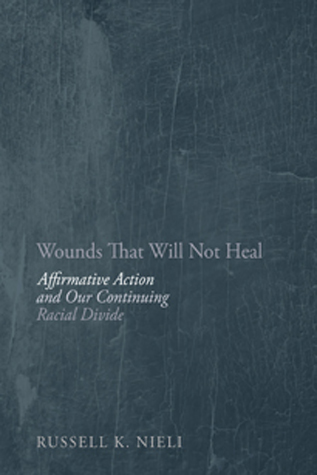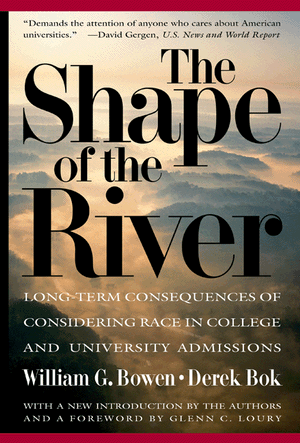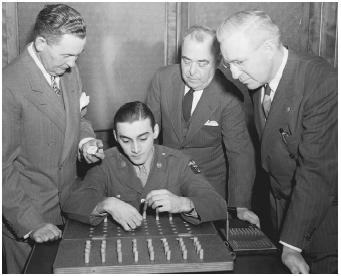Wounds That Will Not Heal, by Princeton lecturer Russell Nieli, is a collection of the most powerful attacks on racial preferences likely to be found in a book by a mainstream publisher. It even touches on the inherent tribalism of man, the possibility of race differences in IQ, and the folly of thinking “diversity” is a strength. Wounds That Will Not Heal makes a few silly brotherhood-of-man concessions to liberalism, but the book is an important part of the fight against “affirmative action,” particularly in universities.
Preferences have sordid origins. How the Civil Rights Act of 1964, which was supposed to ban race discrimination, was turned into a justification for discrimination against whites, is one of the most notorious legal-judicial perversions in American history. Mr. Niele notes that this was exactly what Southern opponents of the law predicted. However the law was worded, and no matter what its supporters promised, those old “racists” knew that the law would end in quotas.
And, as Mr. Niele writes, liberals have always been dishonest about what they were doing. Euphemisms such as “affirmative action,” “goals and timetables,” and “diversity” go over better than “racial preferences” or “discrimination against whites.” Mr. Niele also points out that the initial justification for preferences — compensation for those who had suffered most from discrimination — was always a fraud. Almost all beneficiaries have been middle-class blacks. And ever since the 1978 US Supreme Court Bakke decision, compensation has taken a back seat to the idea that “diversity” is so desirable that it justifies discriminating against whites.
Civil rights or special treatment?
Blacks, of course, welcomed preferences, though Mr. Niele is naive enough to be surprised by that. He recognizes that the civil-rights bargain required people of all races to renounce tribal loyalty, and he thought blacks would do their part. He says that since so many black leaders were ministers, they “would never stand for” the idea of special treatment. He quotes the usual Martin Luther King guff about “content of their character,” and thinks that after King’s death blacks somehow became more tribal.
This only proves that those “racist” Southern congressmen understood blacks better than a Princeton lecturer does. When blacks did not have equal rights they clamored for equality. As soon as they had equality they clamored for special treatment. Both appeals were tribal.
King, himself, made no secret of what he wanted. “[I]f a city has a 30 percent Negro population,” he reasoned, “then it is logical to assume that Negroes should have at least 30 percent of the jobs in any particular company, and jobs in all categories rather than only in menial areas.” King also wanted reparations for slavery. “No amount of gold could provide an adequate compensation for the exploitation and humiliation of the Negro in America down through the centuries,” he wrote, but he would accept “a massive program by the government of special, compensatory measures which could be regarded as a settlement.”
That is exactly what Wounds That Will Not Heal opposes on every page, yet Mr. Niele incongruously dedicated his book to King, “who spoke to our common humanity.”
Mr. Niele may be blind about King, but he has no illusions about King’s successors. He points out that “civil rights” comes from the Latin civilis, meaning of or belonging to citizens. Since civil rights are common to citizens, “to speak of the NAACP or La Raza as ‘a civil rights group’ is a sign of moral and spiritual confusion.”
White attitudes
Mr. Nieli writes that for blacks and Hispanics (henceforth, B&H), preferences mean swag for the tribe. But what’s in it for whites? Mr. Niele has clearly pondered this mystery, and writes that the impulse to support preferences probably comes from growing up middle class and then feeling guilty after discovering there are poor people in the world. He says this can sometimes lead to public-spirited acts, but that the white preferences supporter suffers from:
a kind of demonic self-righteousness and hypocrisy, which induces him to try to expiate his own sense of guilt, not by giving up any of his own wealth or privilege . . . but by using government power to force other people, usually people considerably less well off than himself, to sacrifice their jobs, their lives, and their promotion entitlements.
These are the whites who fawn on “black people, whose disapproval the white ‘liberal’ fears with an intensity bordering on horror.” These whites also romanticize poor blacks, “endowing them with a kind of secular holiness.” Poor whites, on the other hand, are “moral inferiors” if they dare complain about discrimination against them. Mr. Niele suspects that well-off liberals like it when lower-order whites complain because it “reinforce[s] and confirm[s] their own sense of moral and social superiority.”
For Mr. Niele, liberal race thinking is “ultimately narcissistic and self-preoccupied.” It assumes that B&H can hardly move a muscle without white benevolence, and that even if preferences sometimes harm beneficiaries by setting them up for failure, that doesn’t matter because what liberals care about most is self righteousness.
It is rare for a mainstream author to write so cuttingly and incisively about the motives of liberals, and it certainly took courage to denounce the thinking that no doubt prevails at Mr. Niele’s own university. He is also refreshingly — and boldly — angry about the unfairness of preferences, writing about “my own ethnic rage at affirmative action.” According to orthodox thinking, only non-whites are entitled to “ethnic rage;” anything whites ever feel is mean-spirited “resentment” over loss of “privilege.”
Mr. Niele is surprised that whites have not risen up in fury against systematic discrimination against themselves. Instead, they have been cowed by a ruling class that seems to have accepted the idea of “collective and congenital blood guilt.” He finds it “truly alarming” that such a concept could have taken root in America.
The River books
A large part of Wounds That Will Not Heal is devoted to taking apart three books that were funded by the Andrew W. Mellon Foundation to support racial preferences. The best known of this “river” series is The Shape of the River, published in 1998 by William Bowen and Derek Bok, who have been, respectively, presidents of Princeton and Harvard. It was followed by The Source of the River in 2003, and Taming the River in 2009, also by Mellon-supported authors.
The Shape of the River purported to follow the careers of Ivy-League affirmative-action babies and show how marvelously everything turned out for them — and for America. The two others used lengthy student questionnaires to try to prove the same thing. Mr. Niele says the authors are “passionately, even desperately” committed to preferences, and that their books reflect “the extreme ideological one-sidedness that dominates academic sociology.”
The River authors admit that preferences mean lower standards. They also admit that elite schools lie about this, but wish only that administrators lied more convincingly. They think it is a pity that B&H — who know they are less qualified — can’t be persuaded they are just as qualified as whites.
The authors are also dismayed to find that beneficiaries think whites and Asians are smarter and harder working than they are, and that whites and Asians think so too. Blacks are hardest on themselves, and rank themselves as even lazier than whites and Asians do. The authors then lament the power of “negative stereotypes”!
We also learn from the River books that although foreign-born blacks are just 13 percent of the black college-age population, they are 40 percent of the blacks at the top schools, and that black women outnumber black men almost two to one at these schools. Asians have lower self esteem than other students, and although affirmative-action blacks at top schools do not lack for self esteem, the ones who go to black schools have even more.
The authors also write at length about how we must make up for the horrific obstacles ghetto blacks face — while failing to point out that affirmative-action babies are almost invariably middle class. The authors also describe racial segregation as a crippling condition for blacks, but do not mention that it never held back Chinese students or boat people. The River authors agonize over the mental Calvary of being a minority but don’t seem to have noticed that Asians are a minority, too.
In short, Mr. Niele thinks the books are thoroughly mendacious. He also scoffs at the authors for what they left out of their questionnaires. They never asked blacks and Hispanics what they thought of affirmative action, no doubt for “fear of what the answers might be.”
Arguments against
For years, “conservatives” dared oppose preferences only because they threw beneficiaries in over their heads or “devalued the accomplishments” of competent B&H. Mr. Niele gets it right: Preferences are wrong because they are crushingly unfair to whites. He is furious that blacks with SAT scores of 950 to 1050 have a better chance of getting into the University of Virginia than whites with scores of 1350 to 1450 — and he is furious that it took a Freedom of Information request to find this out.
In Mr. Niele’s view, racial discrimination is simply worse than other kinds of discrimination. He notes that after both world wars, veterans’ preferences bills passed overwhelmingly in Congress. Very few people thought they were wrong, and no one had to pretend they were anything but preferential treatment.
Mr. Niele still argues that preferences are bad for the beneficiaries. At elite schools, everyone knows some students don’t belong and got in because of race. Mr. Niele therefore thinks “racial-preference policies serve to heighten rather than reduce racist ideas,” and “strengthen the belief in black inferiority.” This could be true for students, who famously avoid black lab partners, but preferences may fool the rest of the country. It would send a very clear message if Harvard and Yale admitted strictly on ability and had no black students at all.
It is fashionable to worry that there are not enough non-white scientists and graduate students, and Mr. Niele thinks race preferences are part of the problem. He says B&H are more likely to switch out of science majors than whites and Asians, and that this is because they are at schools where the work is too hard for them and they get bad grades. If they had got better grades at lesser schools they might have stayed in science or gone to graduate school.
Mr. Niele quotes the well-known work of Richard Sander, who, with great difficulty, pried admissions data out of law schools. He found that blacks are two full standard deviations behind whites in qualifications and performance, and are twice as likely to drop out, fail, and flunk the bar exam. Prof. Sander thinks that if black law students were better matched to their schools, they would not fall behind, would stay in school, and be more likely to pass the bar exam. In other words, preferences reduce the number of black lawyers.
There are only a few studies that have tried to measure the benefits of “diversity.” Mr. Niele cites one that concluded that the more ruthless the racial preferences, the more they seem to erode academic standards for all students. Another study found that white students do not like preferences, faculty dislike them somewhat less, but administrators claim to like them.
Mr. Niele concludes: “It is difficult to see how more intellectually substandard black and Latino students on college campuses improve race relations, enrich the learning environment for the whites and Asians, or improve the image of blacks and Latinos in the minds of classmates.”
It is common to argue that since B&H know there are systematic preferences, they know they can afford to slough off. John McWhorter of the Manhattan Institute, for example, says he did not work hard in high school because he knew he could breeze into a good school because he is black. Mr. Niele supports this view by pointing out that blacks do worse in school than their test scores suggest they should. Their grades are not as good as those of whites who get the same test scores, and the tougher the school, the wider the gap.
In fact, many blacks — even beneficiaries of blatant preferences — think society is out to oppress them, so they may not be counting on white largess to make up for laziness. Mr. Niele does not consider the possibility that there could be average racial differences in behavior. A black and a white who get the same SAT score may have the same intelligence, but blacks are less able to defer gratification. This could mean they are more likely to goof off than study, which would hurt their grades. Asians are probably better disciplined than whites, which would improve their grades.
However, Mr. Niele does cite research suggesting that when blacks attend black colleges they are more likely to get the grades their SAT scores predict. It is hard to make grade-point comparisons between different colleges, but if this is true it would support Mr. Niele’s sloughing-off theory. There does seem to be no doubt, however, that black students are happier at black colleges — and there is no affirmative action for them there.
Mr. Niele writes that affirmative action is like high-rise apartments for the poor: a benevolent idea that backfired. This comparison is unfair to high-rises. The projects were not hives of degeneracy when poor whites lived in them, and people in Shanghai live in super-high-density apartment blocks. It was blacks who turned apartment buildings into crack houses.
Bad similes aside, let us hope Mr. Niele is right to conclude that “in time affirmative action will come to be viewed as a policy, not a crusade. And as a policy it will be judged by its merits — and found deeply wanting.”
Glimpses of the truth
Despite its generally neoconservative orientation, Mr. Niele’s book contains flashes of dissident insight. He tells us “negative stereotyping” is a “moral failing” and yet he cites Philippe Rushton on the genetic basis of ethnocentrism. He claims that only losers identify with their nation or tribe, but concedes that tribalism is “hard-wired in our brains.” He urges us to embrace American diversity but writes that “ethno-racial homogeneity, not heterogeneity, is more likely to improve local and international competitiveness.” Mr. Niele even mentions the possibility of race differences in average ability; he lists Arthur Jensen, Michael Levin, Richard Lynn, and Philippe Rushton as sources on the hereditarian view — though only in a footnote.
Wounds that Will Not Heal is therefore a strangely fence-sitting book. Mr. Niele would no doubt bristle at being called a race realist, yet he recognizes many of the reasons why whites prefer homogeneity, and it is a significant step forward to have included these arguments. Mr. Niele can write about the “ethnic rage” he feels because of race preferences; why can he not understand the “ethnic rage” of white dispossession? For whatever reason, he does not take the final step: Reject the entire multi-racial project and argue for a society based on human nature rather than egalitarian fantasy.
This term, the US Supreme Court will rule on Fisher v. University of Texas, which could outlaw race preferences completely — at least until the court is packed with more non-whites. Of course, this will not end the lies and corner-cutting. Many states have banned preferences through ballot initiatives — no legislature has had enough backbone to ban them — but colleges practice them anyway. In Florida and Texas, anyone who graduates in the top 10 percent of his high-school class gets into the university system, so the best students even in low-performing all-B&H schools get in, too.
The latest trick is geographic discrimination. Those coveted “diversity” candidates conveniently live in clumps, so schools hire data company to find the clumps and then favor applications from certain addresses.
The problem — and Mr. Niele has covered this as well as anyone — is the contemptible mentality of white elites. Until that changes, no book or Supreme Court decision will make much difference.


